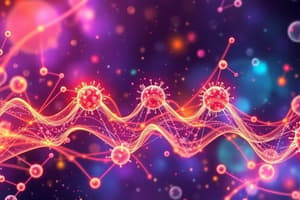Podcast
Questions and Answers
What type of peptide can contribute to undesirable flavors during fermentation?
What type of peptide can contribute to undesirable flavors during fermentation?
- Leucine-leucine-leucine (correct)
- Casein hydrolysates
- Aspartame
- Nisin
What are bioactive peptides known for?
What are bioactive peptides known for?
- Forming disulfide bonds
- Being artificial sweeteners
- Providing health benefits (correct)
- Having antibiotic properties
Which of the following is a bacteriocin used as a food preservative?
Which of the following is a bacteriocin used as a food preservative?
- Cystine
- Aspartame
- Neotame
- Nisin (correct)
What do amino groups of amino acids form when they react with aldehydes or ketones?
What do amino groups of amino acids form when they react with aldehydes or ketones?
What is the primary chemical group in cysteine that forms disulfide bonds?
What is the primary chemical group in cysteine that forms disulfide bonds?
What are nonpolar amino acids primarily characterized by?
What are nonpolar amino acids primarily characterized by?
Which of the following amino acids is considered polar?
Which of the following amino acids is considered polar?
What is a characteristic of acidic amino acids?
What is a characteristic of acidic amino acids?
Basic amino acids are defined as those that:
Basic amino acids are defined as those that:
Which amino acid is classified as an aromatic nonpolar amino acid?
Which amino acid is classified as an aromatic nonpolar amino acid?
Which group of amino acids is characterized by the ability to form hydrogen bonds with water?
Which group of amino acids is characterized by the ability to form hydrogen bonds with water?
Which of the following groups contains only nonpolar amino acids?
Which of the following groups contains only nonpolar amino acids?
Which polar amino acid contains both hydroxyl and amide groups?
Which polar amino acid contains both hydroxyl and amide groups?
Which type of protein is soluble in ethanol?
Which type of protein is soluble in ethanol?
What term describes the sequence of amino acids in a polypeptide chain?
What term describes the sequence of amino acids in a polypeptide chain?
What characterizes the secondary structure of proteins?
What characterizes the secondary structure of proteins?
Which of the following is NOT a common type of tertiary structure?
Which of the following is NOT a common type of tertiary structure?
Proteins that have a quaternary structure consist of what?
Proteins that have a quaternary structure consist of what?
What are the major types of secondary structures in proteins?
What are the major types of secondary structures in proteins?
Which type of bonding primarily stabilizes the secondary structure of proteins?
Which type of bonding primarily stabilizes the secondary structure of proteins?
Proteins that exceed one polypeptide chain are said to have what kind of structure?
Proteins that exceed one polypeptide chain are said to have what kind of structure?
What term describes proteins that consist of two or more monomer subunits?
What term describes proteins that consist of two or more monomer subunits?
Which interactions facilitate the formation of oligomers like dimers or trimers?
Which interactions facilitate the formation of oligomers like dimers or trimers?
Which of the following proteins is an example of a protein that can exhibit quaternary structure?
Which of the following proteins is an example of a protein that can exhibit quaternary structure?
What happens to the protein structure during denaturation?
What happens to the protein structure during denaturation?
Which of the following statements about denaturation is true?
Which of the following statements about denaturation is true?
What is a common result of processing or food digestion on proteins?
What is a common result of processing or food digestion on proteins?
Which type of molecule primarily composes oligomers in proteins?
Which type of molecule primarily composes oligomers in proteins?
What can be said about the reversibility of denaturation?
What can be said about the reversibility of denaturation?
What happens to the hydrophobic amino acids when a protein unfolds?
What happens to the hydrophobic amino acids when a protein unfolds?
Which statement is true regarding enzymes?
Which statement is true regarding enzymes?
What is the significance of a protein's isoelectric point?
What is the significance of a protein's isoelectric point?
How does denaturation affect the properties of proteins?
How does denaturation affect the properties of proteins?
What role do enzymes play in the fermentation process?
What role do enzymes play in the fermentation process?
Which process is necessary to prevent oxidation in fruits and vegetables?
Which process is necessary to prevent oxidation in fruits and vegetables?
What is the consequence of protein denaturation?
What is the consequence of protein denaturation?
What impact does enzyme activity have on food quality?
What impact does enzyme activity have on food quality?
Flashcards are hidden until you start studying
Study Notes
Amino Acid Classification
- Nonpolar amino acids have mostly hydrocarbon R groups and are hydrophobic. There are two types: aromatic (tryptophan and phenylalanine) and aliphatic (glycine, cysteine, methionine, alanine, valine, leucine, isoleucine, and proline).
- Polar amino acids have -OH and/or amide groups that form hydrogen bonds with water (serine, threonine, tyrosine, asparagine, and glutamine).
- Acidic amino acids are negatively charged (aspartic acid, glutamic acid).
- Basic amino acids are positively charged at pH 7.0 and can interact through ionic interactions (lysine, arginine, histidine).
Peptide Bonds
- Peptide bond formation during fermentation contributes to flavor, which can be desirable or undesirable.
- Bitter peptides can be formed (e.g., the tripeptide leucine-leucine-leucine).
- Bioactive peptides may be naturally present in foods or formed through hydrolysis and can offer health benefits (e.g., casein hydrolysates).
- Sweet taste can result from dipeptides like aspartame and neotame, which are used as artificial sweeteners.
- Bacteriocins are peptides with antibiotic properties. Nisin is a bacteriocin approved for use as a food preservative.
Disulfide Bonds
- The sulfhydryl group (-SH) of cysteine is highly reactive and can oxidize to form cystine, creating a disulfide bond or bridge.
Schiff Base Formation
- Free amino groups in amino acids can react with aldehydes or ketones to form imines (Schiff bases).
- This reaction is common in foods where amino acids and reducing sugars are present.
Protein Structure
- Primary structure: The sequence of amino acids in the polypeptide chain.
- Secondary structure: The geometrical arrangement of the polypeptide chain along one axis, due to hydrogen bonding between peptide bonds. Common secondary structures include α-helices and β-pleated sheets.
- Tertiary structure: The three-dimensional structure of proteins, where the polypeptide chains are tightly folded and packed. There are two main types: fibrous and globular.
- Quaternary structure: Proteins with more than one chain can have quaternary structure, which is the number and arrangement of multiple protein subunits in a complex.
Protein Denaturation and Hydrolysis
- Processing, storage, or digestion can alter protein structure.
- Denaturation involves the loss of secondary, tertiary, or quaternary structure, leading to protein unfolding.
- Denaturation does not involve peptide bond cleavage and can be reversible.
Protein Functional Properties
- Solubility: Refers to the ability of a protein to dissolve in a solvent. This is influenced by its primary structure and the surrounding environment.
- Hydration: The ability to bind water molecules, which contributes to texture and moisture content of foods.
- Viscosity: The resistance to flow, which is affected by protein concentration and interactions.
- Gelation: The ability to form a three-dimensional network that traps water.
- Emulsification: The ability to stabilize an emulsion by forming a film at the interface between oil and water.
Enzymes
- Enzymes are proteins with catalytic activity, meaning they speed up chemical reactions.
- Enzymes are not consumed during the reaction.
- Denaturation inactivates enzymes. Blanching of vegetables is an example of enzyme inactivation through denaturation.
Enzyme Roles in Food Processing
- Enzymes are naturally found in foods.
- They can play significant roles in the food industry, both beneficial and detrimental to quality.
- Enzymes are responsible for browning of fruits and vegetables.
- Enzyme inactivation is often needed to prevent undesirable oxidation.
- Enzymes are crucial during fermentation to create desirable characteristics in products like cheese, salami, and pickles.
Summary of Key Points
- Amino acids are the building blocks of proteins.
- Proteins are most stable at their isoelectric point, where the net charge is zero.
- Protein denaturation is the transformation of a protein from its native folded state to an unfolded state.
- Changes in physical properties, such as UV absorption, fluorescence, sedimentation coefficient, and viscosity, can be used to monitor protein denaturation.
Studying That Suits You
Use AI to generate personalized quizzes and flashcards to suit your learning preferences.




